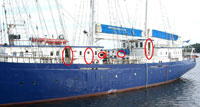
SV Concordia – Open Watertight Doors and Openings Highlighted in Red
We recently posted that Transportation Safety Board of Canada has concluded that poor training played a role in the knockdown and capsizing of SV Concordia. The official Marine Investigation Report examines the events leading up to the capsize in some detail. It is a fascinating report and well worth reading.
How did the ship sink? Contrary to earlier accounts, the Transportation Safety Board found no evidence of a microburst, a sudden and violent downdraft of wind that can reach speed as high as 150 knots. There may have been downdrafts present in the squalls, but nevertheless, the winds in which the ship capsized were no stronger than winds the ship had previously encountered.
The short answer as to why the ship sank is two fold. First, the officer on watch did not perceive the threat to the ship from the approaching squalls and therefore was slow to react when conditions became critical. The second cause for the sinking was simply that several watertight doors and other hatches had been left open on the leeward side of the ship. If these watertight openings had been secured, the additional buoyancy provided by the deck houses would have, in all probability, resulted in the ship surviving the knockdown. Instead, they acted as points of down-flooding which accelerated the capsize. The watertight doors and openings on the weather side of the ship were ordered closed on the approach of the squall lines but the leeward doors were left open, dooming the ship once it was knocked down.
The report also highlights problems with the launching of the rafts, the EPIRBs and other safety equipment.
The main thrust of the report’s recommendations focused on training. The officers aboard the Concordia were all licensed and experienced and yet did not perceive the threat in time to act accordingly. The report notes:
The TSB has identified 2 underlying safety deficiencies as a result of its investigation into this occurrence:
- Guidance information, such as squall curves, is not required on sail training vessels by many flag states.
- Flag states do not require officers to be knowledgeable in the use of guidance information, such as the squall curves, that may be available.

Pingback: Remembering the SV Concordia | Old Salt Blog – a virtual port of call for all those who love the sea